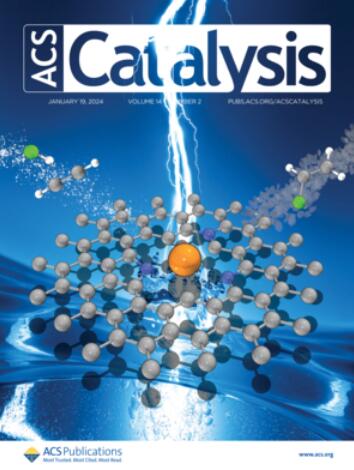Frontline Autocatalysis Mediates the Water Reaction with Single-Layer ZnO
IF 11.3
1区 化学
Q1 CHEMISTRY, PHYSICAL
引用次数: 0
Abstract
The interaction of H2O with oxides is an important step in many chemical processes. However, questions remain about the critical factor that controls the interaction of H2O with oxides. In this work, we investigate the H2O interaction with a single-layer ZnO film grown on Au(111) by using in situ high-pressure scanning tunneling microscopy (HP-STM). It shows that H2O molecules readily dissociate at the domain boundaries of the ZnO film to form the Zn(OH)x domain and reaction fronts between the unreacted ZnO domain and the newly formed Zn(OH)x domain. The reaction rate along the reaction fronts is about 27 times higher than that along domain edges and 3 orders of magnitude higher than that at the domain interior area. Hydroxyl groups at the reaction front can promote adsorption and dissociation of H2O at the adjacent ZnO sites through a local H-bond network, leading to sustained hydroxylation. This dynamic atomic-level observation illustrates the critical role of frontline autocatalysis in surface reactions with water.

前线自催化介导单层ZnO水反应
水与氧化物的相互作用是许多化学过程中的一个重要步骤。然而,控制H2O与氧化物相互作用的关键因素仍然存在疑问。在这项工作中,我们利用原位高压扫描隧道显微镜(HP-STM)研究了水与生长在Au(111)上的单层ZnO薄膜的相互作用。结果表明,H2O分子在ZnO膜的畴边界处容易解离,形成Zn(OH)x畴以及未反应的ZnO畴与新形成的Zn(OH)x畴之间的反应前沿。沿反应锋面的反应速率比沿反应边缘的反应速率高27倍,比在反应区域内的反应速率高3个数量级。反应前沿的羟基可以通过局部氢键网络促进相邻ZnO位点上H2O的吸附和解离,从而导致持续的羟基化。这种动态原子水平的观察说明了前线自催化在与水的表面反应中的关键作用。
本文章由计算机程序翻译,如有差异,请以英文原文为准。
求助全文
约1分钟内获得全文
求助全文
来源期刊

ACS Catalysis
CHEMISTRY, PHYSICAL-
CiteScore
20.80
自引率
6.20%
发文量
1253
审稿时长
1.5 months
期刊介绍:
ACS Catalysis is an esteemed journal that publishes original research in the fields of heterogeneous catalysis, molecular catalysis, and biocatalysis. It offers broad coverage across diverse areas such as life sciences, organometallics and synthesis, photochemistry and electrochemistry, drug discovery and synthesis, materials science, environmental protection, polymer discovery and synthesis, and energy and fuels.
The scope of the journal is to showcase innovative work in various aspects of catalysis. This includes new reactions and novel synthetic approaches utilizing known catalysts, the discovery or modification of new catalysts, elucidation of catalytic mechanisms through cutting-edge investigations, practical enhancements of existing processes, as well as conceptual advances in the field. Contributions to ACS Catalysis can encompass both experimental and theoretical research focused on catalytic molecules, macromolecules, and materials that exhibit catalytic turnover.
 求助内容:
求助内容: 应助结果提醒方式:
应助结果提醒方式:


